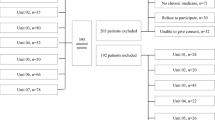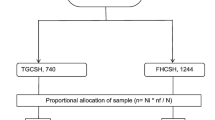Abstract
At admission, unintentional medication discrepancies (UMDs) can occur and may led to severe adverse events. Some of them are preventable through medication reconciliation (MR). As MR is a time-consuming activity, a better identification of high-risk patients of UMDs is mandatory. The objective was to identify risk factors associated with UMDs at admission in an internal medicine department. This prospective observational study was conducted from April 2017 to June 2019. At admission, inpatients had MR to obtain a complete list of home medications. This list was compared to prescriptions made at admission. All discrepancies were classified as intentional or UMDs. Univariate and multivariate analyses to identify the risk factors associated with UMDs were performed. MR was performed on 1157 patients (70.1 ± 16.8 years old); 550 MR (47.5%) contained at least one UMD. More than half of the UMDs (n = 892, 65.6%) corresponded to drug omission. The univariate analysis showed that age (> 60 years old), “living at home”, medication preparation not performed by patient, medication-intake difficulties, number of sources consulted, MR duration, presence of a high-risk drug and the number of home medications were associated with UMDs. In the multivariate analysis, adjusted on the number of sources consulted, independent risk factors were “living at home” and the number of home medications. At admission to an internal medicine department, UMDs were frequent and associated with “living at home” and poly-medication. Our findings might help physicians to identify high-risk patients of UMDs since their admission.



Similar content being viewed by others
Availability of data and material
Yes.
Abbreviations
- ATC:
-
Anatomical, therapeutic and chemical
- MR:
-
Medication reconciliation
- RR:
-
Relative risks
- UMDs:
-
Unintentional medication discrepancies
References
Mueller SK, Sponsler KC, Kripalani S, Schnipper J (2012) Hospital-based medication reconciliation practices: a systematic review. Arch Intern Med 172:1057–1069. https://doi.org/10.1001/archinternmed.2012.2246
Kwan JL, Lo L, Sampson M, Shojania KG (2013) Medication reconciliation during transitions of care as a patient safety strategy: a systematic review. Ann Intern Med 158:397–403. https://doi.org/10.7326/0003-4819-158-5-201303051-00006
Mazhar F, Haider N, Ahmed Al-Osaimi Y et al (2018) Prevention of medication errors at hospital admission: a single-centre experience in elderly admitted to internal medicine. Int J Clin Pharm 40:1601–1613. https://doi.org/10.1007/s11096-018-0737-2
Tam VC, Knowles SR, Cornish PL et al (2005) Frequency, type and clinical importance of medication history errors at admission to hospital: a systematic review. CMAJ Can Med Assoc J J Assoc Med Can 173:510–515. https://doi.org/10.1503/cmaj.045311
Gleason KM, McDaniel MR, Feinglass J et al (2010) Results of the medications at transitions and clinical handoffs (MATCH) study: an analysis of medication reconciliation errors and risk factors at hospital admission. J Gen Intern Med 25:441–447. https://doi.org/10.1007/s11606-010-1256-6
Hias J, Van der Linden L, Spriet I et al (2017) Predictors for unintentional medication reconciliation discrepancies in preadmission medication: a systematic review. Eur J Clin Pharmacol 73:1355–1377. https://doi.org/10.1007/s00228-017-2308-1
Weant KA, Bailey AM, Baker SN (2014) Strategies for reducing medication errors in the emergency department. Open Access Emerg Med OAEM 6:45–55. https://doi.org/10.2147/OAEM.S64174
Quélennec B, Beretz L, Paya D et al (2013) Potential clinical impact of medication discrepancies at hospital admission. Eur J Intern Med 24:530–535. https://doi.org/10.1016/j.ejim.2013.02.007
Redmond P, Grimes TC, McDonnell R et al (2018) Impact of medication reconciliation for improving transitions of care. Cochrane Database Syst Rev 23:10791. https://doi.org/10.1002/14651858.CD010791.pub2
Choi YJ, Kim H (2019) Effect of pharmacy-led medication reconciliation in emergency departments: a systematic review and meta-analysis. J Clin Pharm Ther 44:932–945. https://doi.org/10.1111/jcpt.13019
Graabæk T, Terkildsen BG, Lauritsen KE, Almarsdóttir AB (2019) Frequency of undocumented medication discrepancies in discharge letters after hospitalization of older patients: a clinical record review study. Ther Adv Drug Saf 10:2042098619858049. https://doi.org/10.1177/2042098619858049
Winter SD, Spriet I, Indevuyst C et al (2010) Pharmacist-versus physician-acquired medication history: a prospective study at the emergency department. BMJ Qual Saf 19:371–375. https://doi.org/10.1136/qshc.2009.035014
Reeder TA, Mutnick A (2008) Pharmacist- versus physician-obtained medication histories. Am J Health Syst Pharm AJHP Off J Am Soc Health Syst Pharm 65:857–860. https://doi.org/10.2146/ajhp070292
Rodríguez Vargas B, Delgado Silveira E, Iglesias Peinado I, Bermejo Vicedo T (2016) Prevalence and risk factors for medication reconciliation errors during hospital admission in elderly patients. Int J Clin Pharm 38:1164–1171. https://doi.org/10.1007/s11096-016-0348-8
Chung C, Gauthier V, Marques-Tavares F et al (2019) Medication reconciliation: predictors of risk of unintentional medication discrepancies in the cardiology department. Arch Cardiovasc Dis 112:104–112. https://doi.org/10.1016/j.acvd.2018.09.004
https://www.has-sante.fr/upload/docs/application/pdf/2014-01/3ebat_guide_adm_reduit_261113.pdf
World Health Organization High 5’s: Standard Operating Procedures (2014). http://www.who.int/patientsafety/topics/high-5s/en/, Accessed 4 Jul 2019
Blanchet M (2010) Évaluation de l’impact clinique de la réalisation d’un bilan comparatif des médicaments au Centre hospitalier affilié universitaire de Québec. Pharmactuel 43
WHO|2. Anatomical Therapeutic Chemical (ATC) Classification. In: WHO. http://www.who.int/medicines/regulation/medicines-safety/toolkit_atc/en/. Accessed 6 Feb 2020
Van Buuren S, Groothuis-Oudshoorn K (2011) Mice: multivariate imputation by chained equations in R. J Stat Softw 45:1–67. https://doi.org/10.18637/jss.v045.i03
Gladitz J (1989) Rubin, Donald B.: multiple imputation for nonresponse in surveys. John Wiley & Sons, Chichester—New York—Brisbane—Toronto—Singapore 1987, xxx, 258 S., 6 Abb., £ 30.25, ISSN 0271–6232. Biom J 31:131–132. https://doi.org/10.1002/bimj.4710310118
Karaoui LR, Chamoun N, Fakhir J et al (2019) Impact of pharmacy-led medication reconciliation on admission to internal medicine service: experience in two tertiary care teaching hospitals. BMC Health Serv Res 19:493. https://doi.org/10.1186/s12913-019-4323-7
Baena Parejo MI, Juanes Borrego AM, Altimiras Ruiz J et al (2015) Medication list assessment in Spanish hospital emergency departments. J Emerg Med 48:416–423. https://doi.org/10.1016/j.jemermed.2014.06.063
Abdulghani KH, Aseeri MA, Mahmoud A, Abulezz R (2018) The impact of pharmacist-led medication reconciliation during admission at tertiary care hospital. Int J Clin Pharm 40:196–201. https://doi.org/10.1007/s11096-017-0568-6
Hellström LM, Bondesson Å, Höglund P, Eriksson T (2012) Errors in medication history at hospital admission: prevalence and predicting factors. BMC Clin Pharmacol 12:9. https://doi.org/10.1186/1472-6904-12-9
Cornu P, Steurbaut S, Leysen T et al (2012) Effect of medication reconciliation at hospital admission on medication discrepancies during hospitalization and at discharge for geriatric patients. Ann Pharmacother 46:484–494. https://doi.org/10.1345/aph.1Q594
Damlien L, Davidsen N, Nilsen M et al (2017) Drug safety at admission to emergency department: an innovative model for PRIOritizing patients for MEdication Reconciliation (PRIOMER). Eur J Emerg Med Off J Eur Soc Emerg Med 24:333–339. https://doi.org/10.1097/MEJ.0000000000000355
Belda-Rustarazo S, Cantero-Hinojosa J, Salmeron-García A et al (2015) Medication reconciliation at admission and discharge: an analysis of prevalence and associated risk factors. Int J Clin Pract 69:1268–1274. https://doi.org/10.1111/ijcp.12701
Cornish PL, Knowles SR, Marchesano R et al (2005) Unintended medication discrepancies at the time of hospital admission. Arch Intern Med 165:424–429. https://doi.org/10.1001/archinte.165.4.424
Mendes AE, Lombardi NF, Andrzejevski VM et al (2016) Medication reconciliation at patient admission: a randomized controlled trial. Pharm Pract 14:656. https://doi.org/10.18549/PharmPract.2016.01.656
Unroe KT, Pfeiffenberger T, Riegelhaupt S et al (2010) Inpatient medication reconciliation at admission and discharge: a retrospective cohort study of age and other risk factors for medication discrepancies. Am J Geriatr Pharmacother 8:115–126. https://doi.org/10.1016/j.amjopharm.2010.04.002
Pippins JR, Gandhi TK, Hamann C et al (2008) Classifying and predicting errors of inpatient medication reconciliation. J Gen Intern Med 23:1414–1422. https://doi.org/10.1007/s11606-008-0687-9
Coleman EA, Smith JD, Raha D, Min S (2005) Posthospital medication discrepancies: prevalence and contributing factors. Arch Intern Med 165:1842–1847. https://doi.org/10.1001/archinte.165.16.1842
Salanitro AH, Osborn CY, Schnipper JL et al (2012) Effect of patient- and medication-related factors on inpatient medication reconciliation errors. J Gen Intern Med 27:924–932. https://doi.org/10.1007/s11606-012-2003-y
Marinović I, Marušić S, Mucalo I et al (2016) Clinical pharmacist-led program on medication reconciliation implementation at hospital admission: experience of a single university hospital in Croatia. Croat Med J 57:572–581. https://doi.org/10.3325/cmj.2016.57.572
Dufay É, Doerper S, Michel B et al (2017) High 5s initiative: implementation of medication reconciliation in France a 5 years experimentation. Saf Health 3:6. https://doi.org/10.1186/s40886-017-0057-6
Carnovale C, Mazhar F, Pozzi M et al (2018) A characterization and disproportionality analysis of medication error related adverse events reported to the FAERS database. Expert Opin Drug Saf 17:1161–1169. https://doi.org/10.1080/14740338.2018.1550069
Scott IA, Hilmer SN, Reeve E et al (2015) Reducing inappropriate polypharmacy: the process of deprescribing. JAMA Intern Med 175:827–834. https://doi.org/10.1001/jamainternmed.2015.0324
Beers MH, Munekata M, Storrie M (1990) The accuracy of medication histories in the hospital medical records of elderly persons. J Am Geriatr Soc 38:1183–1187. https://doi.org/10.1111/j.1532-5415.1990.tb01496.x
Author information
Authors and Affiliations
Contributions
Conceptualization: MM, CY, JL, BD, ML. Methodology: MM, CY, BD, ML. Formal analysis and investigation: MM, CY, JL, BD, ML. Writing—original draft preparation: MM, CY, ML. Writing—review and editing: MM, CY, JL, LA, EB, BD, ED, PO, MD, ML. Supervision: BD, PO, ML.
Corresponding author
Ethics declarations
Conflict of interest
The authors declare that they have no conflict of interest.
Additional information
Publisher's Note
Springer Nature remains neutral with regard to jurisdictional claims in published maps and institutional affiliations.
Supplementary Information
Below is the link to the electronic supplementary material.
Rights and permissions
About this article
Cite this article
Masse, M., Yelnik, C., Labreuche, J. et al. Risk factors associated with unintentional medication discrepancies at admission in an internal medicine department. Intern Emerg Med 16, 2213–2220 (2021). https://doi.org/10.1007/s11739-021-02782-0
Received:
Accepted:
Published:
Issue Date:
DOI: https://doi.org/10.1007/s11739-021-02782-0




